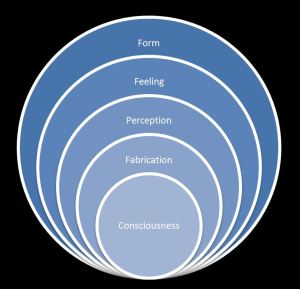A few nights ago, I was practicing Samatha meditation with my eyes open. I decided that I would use directed attention at first toward the function of sight, I went through the usual relaxing process from toe to head. As my mind began to settle, I noticed that the actual configuration of the angles of my eyes would naturally change along with the level of calm and stillness. As the angle changed the external information being received began to fall out of focus and my true focal point grew closer and closer. Soon my mind had calmed and entered into Jhana, and then the next Jhana ( the relevant material is found under the heading “The Four Jhanas”), as my directed thoughts turned to a more unified awareness. The “focal point” continued to reach inward but at a much slower rate. In actuality, it had become pointed toward the Third eye area within the location of the head.
In this process there is always the subtle tensions of minutely small static that can be perceived by the muscular control of the eyes as I continue to let go of more and more form on the subtlest of levels. And then stabilization brings that unifying imperturbable calm. At this point consciousness seems to be releasing control of the physical optical processes altogether in order to maintain this state of calm.
I found that every discrepancy in release would be accompanied by a physical movement of the eye as if to draw attention to some aspect of the 5 Aggregates; Form, Feeling, Perception, Fabrication, and Consciousness. I found that I could not cling to any phenomenon without subtle control of the optic process, nor could any movement of the same process occur without signifying a brief or almost undetectable form of attachment to a phenomenon.
This process brought about great clarity of what is meant and useful about the teachings on the 5 aggregates. This experience allowed access to the depth of what is meant by Form, and the levels of relevance and irrelevance of this Aggregate. I could see how Form is used by the mind as a marker that the mind can fill with potentials that justify the rise and fall of both skillful and unskillful states. It becomes easy to see how Form is abused by the mind when put into the perspective of how it even comes into being. Essentially it ends up being the scapegoat for every experience the mind has conjured up through craving, with or without an object to crave.
These insights have been invaluable in allowing access to the reality of how the mind constructs “reality”. Without knowing how the mind is using these aggregates, we have no real understanding of depth of our “self” induced sufferings. The challenge continues to grow, but so does the view of the Path that leads to the end of suffering. This particular insight has changed the way in which I interact with Form altogether, adding a new layer of understanding to its emptiness.
My mind will no longer be able to manipulate me into maintaining the many strongholds of delusion, that place accountability for my experience anywhere but within.
In sorting out this experience, I have found a small book by Thanissarro Bhikkhu, called “A Burden Off the Mind: A Study Guide on the Five Aggregates” to be a tremendous help. It takes the teachings on the aggregates and places them into the greater context of the Path to the ending of suffering. The link provided offers a free collection of some of the best teachings on meditation and Buddhism that one can find. Without having a physical teacher, Thanissarro Bhikkhu’s writings have been the next best thing.
May your journey continue to bear lots of fruit!
Peace
Loren


